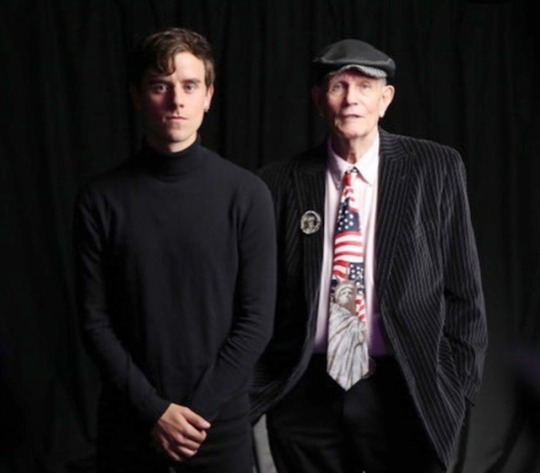#randy wicker
Text

Marsha P. Johnson at home | ph: Randy Wicker
#op#photography#marsha p johnson#randy wicker#exact date unknown#1980s#(fairly sure)#trans women#black trans women#trans queens#black queens#drag queens
8K notes
·
View notes
Text



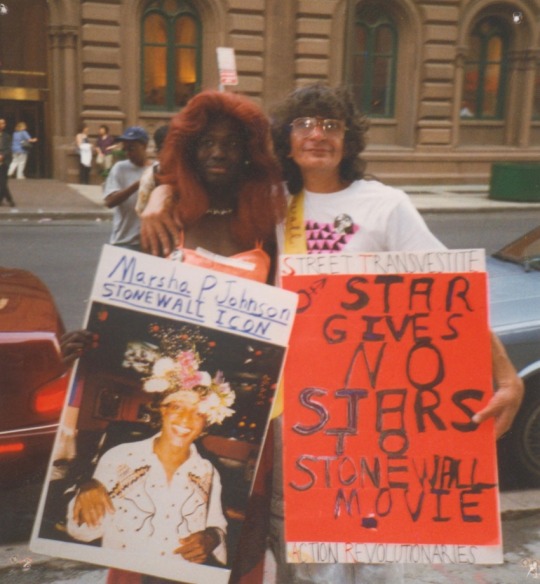
from the digital transgender archive - "photographs of Sylvia Rivera protesting the 1996 "Stonewall" film with a group including Ivan Valentin, Cocoa Rodriguez, Randy Wicker, and Martin Duberman" & "a photograph of Sylvia Rivera with Cocoa Rodriguez holding Stonewall posters protesting the 1996 Stonewall film premiere"
#digital transgender archive#sylvia rivera#cocoa rodriguez#randy wicker#martin duberman#ivan valentin#transgender history#stonewall#stonewall film#transgender activists#marsha p. johnson#queer history#trans rights#gay righs#ph
6 notes
·
View notes
Text
The way I feel about Mattachine and the Daughters of Bilitis is the same way I feel about my parents.
They did their best. But they hurt me. They improved on what came before, but they did not understand the harms they were causing.
#queer history#historical lesbians#history is gay#queer as fact#queer#gay#lesbian#history#lgbtqia#asexual#trans#transgender#marsha p johnson#randy wicker#sylvia rivera#act up#queer rights#harvey milk#barbara getting
3 notes
·
View notes
Text
Celebrating Black Queer Icons:
Marsha "Pay It No Mind" Johnson
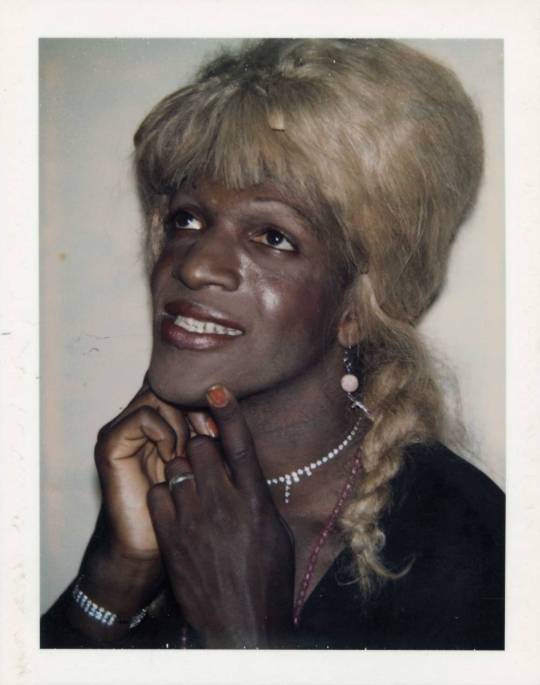

Johnson was born August 24, 1945. A drag queen and sex worker, after moving to New York City from Elizabeth, New Jersey, Johnson is probably best known for participation in Queer Liberation and AIDS activism from 1969 until her death in 1992. While often associated with transgender women, Johnson self identified as gay, a transvestite, and a queen and actively distinguished her identity from the contemporary transsexual community. As for Johnson's gender? Well, pay it no mind. Johnson's activism began in 1969 after being involved in the Stonewall Inn Riots. She is often attributed as being in the riot's vanguard, alongside Zazu Nova and Jackie Hormona. Johnson would later go on to deny this, and is quoted as saying she did not arrive until after the riots had already started. Johnson would later go on to join the Gay Liberation Front and co-found STAR (Street Transvestite Action Revolutionaries), with Silvia Rivera. STAR would open the STAR House in 1970, which acted as a home for gay and trans homeless youths. In 1973 Johnson and Rivera were both temporarily banned by a gay/lesbian committee, from participating in pride parades, because it was said queens were giving the movement "a bad name". This did not deter Johnson. Starting in 1980 Johnson began living with fellow activist, Randy Wicker, and his partner. Johnson, who was HIV positive, would later become Wicker's partner's caregiver as they became terminally ill due to AIDS. After visiting Wicker's partner in the hospital Johnson became dedicated to spending time with AIDS patients and engaged in street actions with groups like ACT UP. Johnson was a deeply religious person throughout her life. Primarily Catholic, Johnson was said to have a very direct and personal relationship with divinity. On July 6, 1992, Johnson's body was found in the Hudson River. Johnson was cremated and after a march down 7th Avenue her ashes were spread in the Hudson. While initially ruled a suicide by the NYPD, this is highly contested to this day, with good reason. In 2002 Johnson's death was reclassified as Undetermined, and efforts in 2012 and 2016 have seen moderate success in getting the case reopened and re-investigated.
In the wake of her death Marsha P Johnson has become a nigh universal icon in queer communities and seemed like a good starting point for Black History Month. Moving forward I hope to focus on people less known, at least in melanin deficient circles. In a perfect world this would be daily, but I sadly don't have the spoons for it. I will effort to post at least 2-3 of these each week and have a list sufficient enough to carry me through February, and a little beyond. I plan on doing Willmer Broadnax next and have a list going that should cover at least the month of February, and hopefully beyond. Corrections and suggestions are welcome and much desired.
#celebrating black queer icons#black history#black history month#black history is queer history#black history is american history#marsha p johnson#marsha pay it no mind johnson#gay liberation front#street transvestite action revolutionaries#STAR Home#stonewall
315 notes
·
View notes
Text



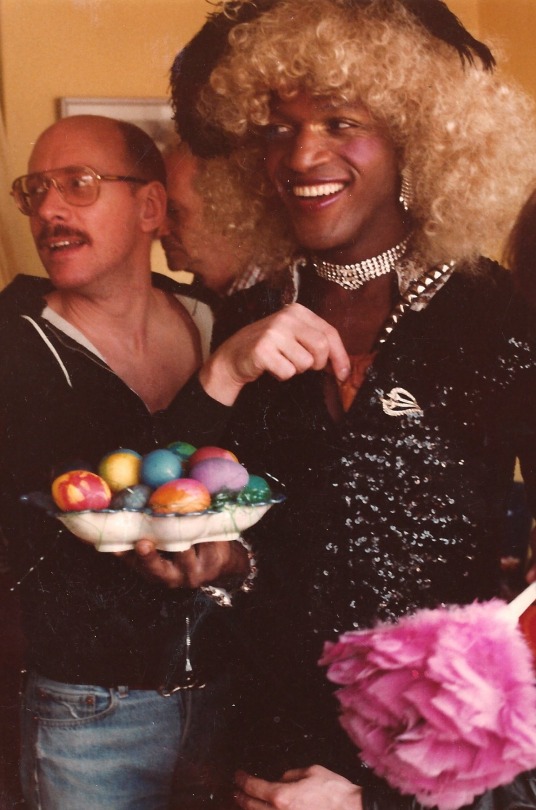



subtitlebuoy | flowers at your feet by texas isaiah | something that may shock and discredit you by daniel mallory ortberg | Martha P. Johnson and friends ph. Randy Wicker | transsexual-menace | autoneurotic
11 notes
·
View notes
Text
This week marks the 20th anniversary of Marcus Nispel’s The Texas Chainsaw Massacre, a remake of Tobe Hooper’s iconic The Texas Chain Saw Massacre. Nispel’s gory and grungy slasher is hardly a great piece of cinema, but it is a surprisingly important one. Texas Chainsaw Massacre altered the course of mainstream populist horror cinema, at least for a couple of years, by ushering in an era of horror remakes.
Pop culture is inevitably guided by larger trends. This is particularly true of horror cinema, where the tendency to make movies cheaply and quickly allows studios to chase popular fads. The Texas Chainsaw Massacre arrived at the end of one such fad. The renaissance in teen slasher movies sparked by the release of Scream in December 1996 was already dying down, giving way to diminishing returns like Scream 3 and Urban Legend: Final Cut along with spoofs like Scary Movie.
That late ’90s slasher fad was self-evidently nostalgic. In Scream, film nerd Randy (Jamie Kennedy) pauses a pivotal scene from John Carpenter’s Halloween to explain the rules of the slasher movie. Scream writer Kevin Williamson would go on to work on the slasher sequel Halloween H20, which would include a sequence of its characters watching Scream 2. However, there was a layer of irony and self-awareness to this nostalgia. These movies referenced classics, but stood apart from them.
The Texas Chainsaw Massacre removes that layer of self-reflexive irony. It doesn’t just pay homage to one of the classics of American horror, it straight up remakes it. It reboots the franchise and starts over, as if offering a young moviegoing audience a chance to witness their version of the beloved horror movie. The gambit worked. The movie grossed $29.1 million in its opening weekend. “To say that it exceeded [our] expectations is an understatement,” conceded David Tuckerman of New Line Cinema.
Nispel’s remake had a profound impact on both the franchise and the larger industry. While many other major classic horror franchises, like Nightmare on Elm Street or Friday the 13th, tended to slow down as they entered the new millennium, Texas Chainsaw Massacre roared to life. The franchise has released more entries in the past twenty years than it did in the previous thirty, including the reboot, a prequel to the reboot, two sequels to the original, and a separate prequel to the original.
The Texas Chainsaw Massacre made an even bigger impression on the horror genre as a whole. For the next seven years or so, theaters were flooded with remakes of 1970s and 1980s horror classics: Dawn of the Dead, The Amityville Horror, House of Wax, The Fog, Assault on Precinct 13, Black Christmas, The Hills Have Eyes, The Omen, When a Stranger Calls, The Wicker Man, The Hitcher, Prom Night, Friday the 13th, Sorority Row, The Stepfather, My Bloody Valentine, and many more.
Of course, trends do not exist in isolation. These remakes overlapped with a similar push to adapt Japanese horrors like Ring and The Grudge for American audiences. More interestingly, they seemed to unfold in parallel with the “torture porn” fad, which really kicked into gear with the release of Saw in October 2004 and Hostel in January 2006. Both trends seemed to be displaced by the embrace of “found footage,” and many of these remakes were notably gorier than the originals.
It’s worth revisiting this trend in general and Nispel’s Texas Chainsaw Massacre in particular. There is a tendency to overlook the horror genre in discussions of popular cinema. This is most obvious when it comes to awards recognition, but also applies to general discussions of the artform. There’s also an understandable impulse to dismiss these sorts of remakes as inherently unworthy of discussion or scrutiny. Five years ago, Keith Phipps noted that these remakes were largely forgotten.
One of the more interesting – and frustrating – aspects of Nispel’s remake is the fact that it is a horror movie that exists in the context of decades of slasher movies. Tobe Hooper’s Texas Chain Saw Massacre may not have been the first slasher movie, but it was released before Halloween codified the conventions of the genre. Even watched today, The Texas Chain Saw Massacre is a delightfully and unsettlingly odd experience. It can seem uncanny to a viewer versed in the films that followed.
Hooper’s Texas Chain Saw Massacre begins with a sense of a world that is unraveling, reflecting the chaos of the early 1970s. It begins with a news broadcast about the handing down of an indictment, an invocation of Watergate. Sally (Marilyn Burns) and Franklin Hardesty (Paul A. Partain) are traveling with their friends to visit their grandfather’s grave, following a series of desecrations in the region. There’s an apocalyptic vibe to all this, recalling George A. Romero’s Night of the Living Dead.
In contrast, Nispel’s remake is much more conventional in its framing. It is set in 1973, but there is no real sense that the larger world is collapsing. None of that apocalyptic dread hangs in the air. These teenage leads are not investigating a case of potential grave robbery. Instead, they are driving to a Lynyrd Skynyrd concert after purchasing drugs in Mexico. This is a standard start to a slasher like this. The teenagers transgressed, so will be punished. They broke the rules, so must die.
In contrast to the irony that defined the meta-slashers of the previous few years, this is all played remarkably straight. The movie’s final girl, Erin (Jessica Biel), is entirely innocent. She is shocked to discover that her friends used the trip to Mexico as an excuse to buy marijuana. Her friend Kemper (Eric Balfour) jokes that she didn’t even drink the tequila down there. As such, Erin’s survival feels like it plays the socially conservative tropes of the slasher movie remarkably straight.
To give the movie some credit, it is at least somewhat equal opportunity in terms of the violence it inflicts on its teenage victims. In Hooper’s Texas Chain Saw Massacre, the male characters tended to die quickly while the female characters suffered longer. Nispel’s Texas Chainsaw Massacre reverses that dynamic somewhat. Pepper (Erica Leerhsen) dies abruptly in the distance, while Andy (Mike Vogel) hangs from a meat hook in place of Pam (Teri McMinn) in the original.
That said, The Texas Chainsaw Massacre is hardly a reconstructed slasher movie. Nispel’s camera lingers on Jessica Biel, particularly her exposed midriff. It seems to luxuriate in shots of her running and panting. It’s an approach that feels very similar to how Michael Bay’s camera would treat Megan Fox during the Transformers films a few years later. Biel may not be hanging on a hook, but there are certainly times when Texas Chainsaw Massacre treats the actor as a piece of meat.
There is a sense that the remake is revisiting the original through the lens of the decades of slasher movies that followed, smoothing down the rougher edges of the original film to make it more easily fit within an established template. This is true of most of the uninspired remakes that followed, which would take messy and clumsy original films that were figuring out what these horror movies looked like in real time, and apply a “one-size-fits-all” structure to them.
These movies could be grungy and grimy. They could feature graphic gore. However, these remakes also tended to be products of a more ruthlessly efficient studio system than the films that inspired them. The Texas Chainsaw Massacre sets early scenes to Lynyrd Skynyrd’s Sweet Home Alabama, a song that the original could never have afforded to include. Biel and Balfour may not have been movie stars, but they are more established than any actors in the original. There is a polish to these remakes that exists at odds with the power of the original.
Notably, there is no sense of mystery or ambiguity to Leatherface (Andrew Bryniarski) in The Texas Chainsaw Massacre. The film offers the iconic horror villain a backstory involving horrific skin disease and even a name: Thomas Hewitt. Hooper’s original film was so scary because it suggested that this violence couldn’t be explained or rationalized. It had the logic of a nightmare. It’s very hard to replicate that sense of existential dread when so much of the appeal of a remake is the familiarity.
Then again, perhaps this makes a certain amount of sense in context. As with the “torture porn” trend, these horror remakes were largely a product of the Bush era. They existed in the context of the War on Terror. This may explain why they were so much more graphic than the original, and why they tended to fixate upon torture and brutality. The War on Terror was defined by a desire to understand the horrors lurking out in the darkness, to understand, “Why do they hate us?”
Released a little more than two years after 9/11, Nispel’s Texas Chainsaw Massacre is rooted in that moment. The biggest alteration to the original narrative is the introduction of R. Lee Ermey as Sheriff Hoyt, a sadistic local law enforcement official who feels more at home in Deliverance rather than The Texas Chain Saw Massacre. Hoyt is a product of the Bush era. A former governor of Texas, Bush was likened to a western sheriff when he boasted about posting “Wanted” signs in the wake of the attacks.
Hoyt physically and psychologically brutalizes these teenagers. He forces Morgan (Jonathan Tucker) to reenact a suicide that the characters witnessed, pushing Morgan to place what he believes to be a loaded gun in his mouth. When Morgan resists, Hoyt handcuffs him and loads him into the back of his police car. He takes Morgan away, but not to experience due process. On the drive, he smashes a nearly empty bottle of liquor in Morgan’s face. It seems likely that Morgan is just going to disappear.
This is perhaps the most unsettling sequence in the film. It resonates with contemporary anxieties over the “enhanced interrogations” and “extraordinary renditions” that defined the War on Terror. Of course, Hoyt doesn’t have any authority to do what he is doing. In perhaps the film’s sharpest jab at the Bush administration, it is eventually revealed that Hoyt isn’t even really the local sheriff. None of this is as overt as the cultural context of Hooper’s original, but these are films of their moment.
The Texas Chainsaw Massacre is ultimately an underwhelming, generic, and gory imitation of a much richer film. It takes one of the most transgressive horror films of its era, and reduces it down to a standard slasher template. In doing so, it provided a sustainable model for mainstream horror over the next few years, an assembly line that could reliably churn out low-budget and low-effort films to solid box office returns.
In its own weird and grotesque way, Nispel’s Texas Chainsaw Massacre turned mainstream horror into a charnel house. It pushed away from the knowing detachment of the self-aware slashers, and embraced a more direct mode of recycling. It carved up the corpses of classic horror movies to be repackaged as subprime cuts.
8 notes
·
View notes
Text
23 Republican Senators & 124 Congressmen signed an amicus brief to the Supreme Court asking for a 50 state ban on mifepristone, a drug safer than tylenol that is standard treatment for abortion & miscarriages, "due to safety concerns".
The brief DARES to argue that banning the life saving drug would save women from 'reproductive control'. (x)
These 147 people would rather have women die of sepsis than let women control their own bodies. If your representatives are on this list, call them and tell their office you will be voting against them in the next election because they asked SCOTUS to throw the US medical drug system into chaos at the cost of American lives.
United States Senate
Lead Senator: Cindy Hyde-Smith (MS)
John Barrasso (WY)
Mike Braun (IN)
Katie Britt (AL)
Ted Budd (NC)
Bill Cassidy (LA)
Kevin Cramer (ND)
Mike Crapo (ID)
Ted Cruz (TX)
Steve Daines (MT)
Josh Hawley (MO)
John Hoeven (ND)
James Lankford (OK)
Mike Lee (UT)
Cynthia Lummis (WY)
Roger Marshall (KS)
Markwayne Mullin (OK)
James Risch (ID)
Marco Rubio (FL)
Rich Scott (FL)
John Thune (SD)
Tommy Tuberville (AL)
Roger Wicker (MS)
United States House of Representatives
Lead Representative: August Pfluger (TX–11)
Robert Aderholt (AL–04)
Mark Alford (MO–04)
Rick Allen (GA–12)
Jodey Arrington (TX–19)
Brian Babin (TX–36)
Troy Balderson (OH–12)
Jim Banks (IN–03)
Aaron Bean (FL–04)
Cliff Bentz (OR–02)
Jack Bergman (MI–01)
Andy Biggs (AZ–05)
Gus Bilirakis (FL–12)
Dan Bishop (NC–08)
Lauren Boebert (CO–03)
Mike Bost (IL–12)
Josh Brecheen (OK–02)
Ken Buck (CO–04)
Tim Burchett (TN–02)
Michael Burgess, M.D. (TX–26)
Eric Burlison (MO–07)
Kat Cammack (FL–03)
Mike Carey (OH–15)
Jerry Carl (AL–01)
Earl L. “Buddy” Carter (GA–01)
John Carter (TX–31)
Ben Cline (VA–06)
Michael Cloud (TX–27)
Andrew Clyde (GA–09)
Mike Collins (GA–10)
Elijah Crane (AZ–02)
Eric A. “Rick” Crawford (AR–01)
John Curtis (UT–03)
Warren Davidson (OH–08)
Monica De La Cruz (TX–15)
Jeff Duncan (SC–03)
Jake Ellzey (TX–06)
Ron Estes (KS–04)
Mike Ezell (MS–04)
Pat Fallon (TX–04)
Randy Feenstra (IA–04)
Brad Finstad (MN–01)
Michelle Fischbach (MN–07)
Scott Fitzgerald (WI–05)
Mike Flood (NE–01)
Virginia Foxx (NC–05)
Scott Franklin (FL–18)
Russell Fry (SC–07)
Russ Fulcher (ID–01)
Tony Gonzales (TX–23)
Bob Good (VA–05)
Paul Gosar (AZ–09)
Garret Graves (LA–06)
Mark Green (TN–07)
Marjorie Taylor Greene (GA–14)
H. Morgan Griffith (VA–09)
Glenn Grothman (WI–06)
Michael Guest (MS–03)
Harriet Hageman (WY)
Andy Harris, M.D. (MD–01)
Diana Harshbarger (TN–01)
Kevin Hern (OK–01)
Clay Higgins (LA–03)
Ashley Hinson (IA–02)
Erin Houchin (IN–02)
Richard Hudson (NC–09)
Bill Huizenga (MI–04)
Bill Johnson (OH–06)
Mike Johnson (LA–04)
Jim Jordan (OH–04)
Mike Kelly (PA–16)
Trent Kelly (MS–01)
Doug LaMalfa (CA–01)
Doug Lamborn (CO–05)
Nicholas Langworthy (NY–23)
Jake LaTurner (KS–02)
Debbie Lesko (AZ–08)
Barry Loudermilk (GA–11)
Blaine Luetkemeyer (MO–03)
Tracey Mann (KS–01)
Lisa McClain (MI–09)
Dr. Rich McCormick (GA–06)
Patrick McHenry (NC–10)
Carol Miller (WV–01)
Mary Miller (IL–15)
Max Miller (OH–07)
Cory Mills (FL–07)
John Moolenar (MI–02)
Alex X. Mooney (WV–02)
Barry Moore (AL–02)
Blake Moore (UT–01)
Gregory F. Murphy, M.D. (NC–03)
Troy Nehls (TX–22)
Ralph Norman (SC–05)
Andy Ogles (TN–05)
Gary Palmer (AL–06)
Bill Posey (FL–08)
Guy Reschenthaler (PA–14)
Mike Rogers (AL–03)
John Rose (TN–06)
Matthew Rosendale, Sr. (MT–02)
David Rouzer (NC–07)
Steve Scalise (LA–01)
Keith Self (TX–03)
Pete Sessions (TX–17)
Adrian Smith (NE–03)
Christopher H. Smith (NJ–04)
Lloyd Smucker (PA–11)
Pete Stauber (MN–08)
Elise Stefanik (NY–21)
Dale Strong (AL–05)
Claudia Tenney (NY–24)
Glenn Thompson (PA–15)
William Timmons, IV (SC–04)
Beth Van Duyne (TX–24)
Tim Walberg (MI–05)
Michael Waltz (FL–05)
Randy Weber, Sr. (TX–14)
Daniel Webster (FL–11)
Brad R. Wenstrup, D.P.M. (OH–02)
Bruce Westerman (AR–04)
Roger Williams (TX–25)
Joe Wilson (SC–02)
Rudy Yakym (IN–02)
If your representatives are on this list, call them and tell their office you will be voting against them in the next election because they asked SCOTUS to throw the US medical drug system into chaos at the cost of American lives.
Help to patients who have to cross state lines to get medical care by donating to your local abortion fund here. (x)
#scotus#abortionpill#state of the uterus#abortion rights are human rights#us politics#miscarriage#vote blue#nnaf#yellowhammer
24 notes
·
View notes
Text
Stonewall History
The newest teaching from The Church of Transgenderism is that "Trans" people were a vital part of the uprising. That from the beginning of gay liberation to equal rights to marriage equality was ushered in and done by "trans" people.
This is just a lie. Their entire ideology didn't even take form until the 90's. "Cis", a slur, wasn't even used as it pertains to humans until the early 1990's. I think in order to be a cult member of transgenderism you have to first lie to yourself to the point where truth does not matter.
So I missed Stonewall day on the 28th but I want to remind some of the truth of the story of Stonewall.
The night of June 27, 1969 is a historic turning point for contemporary LGB rights in the United States. A routine police raid on the Stonewall Inn in New York City, because it was a gay bar, resulted in a push back by the LGB community. It was a violent response to the long history of getting beaten and assaulted with impunity by the police and community at large.
We often hear "Marsha threw the first brick at Stonewall" but that is a myth. In a later interview with gay historian Randy Wicker, Marsha said that he was not at Stonewall in the early hours when the riot first exploded on June 28, 1969. He was uptown at a party. When he arrived at Stonewall, it was already, in his words, "on fire." Sylvia Rivera was not there the first night at all. He was asleep in Bryant Park.
The truth is that while patrons were being escorted out of the bar all beaten and bloody someone yelled, "Why don't you do something?" and that was the catalyst for fighting back. The person who said and began the fight back was Stormie DeLarverie. A butch bi-racial drag king. Charles Kaiser's 1995 book, The Gay Metropolis: The Landmark History of Gay Life in America, Kaiser makes a case that DeLarverie deserves the credit for mobilizing the patrons of the Stonewall Inn to fight back.
Stormé has been almost entirely erased from the Stonewall narrative. Isn't that odd? It's like the TQ just want to center men. A few years ago, a group of lesbians wanted to march in NYC Pride with a banner that read: "Everyone knows Stormé started Stonewall." The group was banned by NYC Pride and unable to march.
Marsha and Sylvia deserve some credit for later on organizing and protesting but to tie them to Stonewall is disingenuous.
9 notes
·
View notes
Text
QAI like Chaunette Shaw's interior and lifestyle but we have WAGs or journos who show a little piece of their privacy certain trolls are able to recognise Tazer's kitchen in the background of his new gf's photo. Apparently Toews Kane/Crosby Interesting/Ashetoewsgurl has recognised Toews's black kitchen from the video for Drew Barrymore's TV show.


Caley Cheelios invites you from time to time to her garden with chicken or her kitchen with her dancing children. Other WAGs are IN influencers and we see their house often. Other women are just panning their faces against the white wall and small peak or one photo of the coffee machine next to old painting or yellow candle holders next to candle is a pinnacle of revealing privacy.

Elina Cassell, Hjalmarsson before has revealed her home taste matching her similar fashion style in Scandinavian decor. Elina has posted photos of her home design signed as interior designer Elina.


Compared to

When fashion style (her party dress is nice and sleak or sexy) meets home décor or her multiple mentioned favourite NHL example Auston Matthews who is known for his eclectic fashion style. Yes, Troll's favourite target beside WAGs, a sport commentator/biz woman Marketa BLW and her countryside pad. Still more personality than Royal Christmas photo with dull beige walls next to cheap shiny Christmas gift box. Yuk. Like a modern wicker lampshade.

i have been thanked by Marketa's US lawyers led by her long term ex bf lawyer from Santa Barbara who are checking whether Rachel Meghan Markle has used anything from Marketa's estates Balmoral and Sandringham where Catherine, Princess of Wales got a boot from Anmer Hall, already locks changed as their illegal sublet is not worthy of paper. Marketa takes full control and intellectual possession of he estates since January 1,2023. I should forward the notice that any photo opt or visit up to this date without her consent will be tackled in the court rooms and female in laws such as Kate Middleton are advised to hire an expert's in the field of nominee trust and property law rather than a media lawyer because they prefer clothes and media attention. District Judge Russell of Norwich court, UK has made couple of serious procedural irregularities in past and media lawyer Miss Prince who was not an expert in nominee trust and real estate law has exchanged two emails as off court communication with late response to the case against Catherine Mountbatten Windsor, nee Middleton, Princess of Wales. Marketa BLW has confirmed that the royals and so Queen breach regularly independence of justice in UK and late Queen has ordered to stop a court case by Daily Mail against Rachel Meghan Markle who is still seen as a part of Royal Family despite their attitude and public opinion.
I was told Thank you for an alert and informed that they lodged a lawsuit against Canadian troll Ashley who is behind two fan blogs, one fan IN account and insane blabbing about Crosby and Marketa on Blogger. It explains how certain crazies knows how certain women stating outside of the press and social media are recognised after ten years. I would struggle to recognise Zach Parise or Taylor Johnson now . It explains why I am Lee now - a fictional character of Mrs Troll on her old sci fi blog to Randy Morin being called Marketa himself.. Toews has been apparently advised to unfollow her and so Marcus Aubrey from Austin, Texas for his charlatan like pseudo medicine pedalling psychedelic stuff, steroids etc, hatred about races and Jews and promotion of Donald Trump with conspiracy theories.
With permission of Marketa's lawyers and upon their request as she will be accountable for any possible defamation Jonathan Toews's slump in absence of offense is not caused by physical side but mental one and unlinked to the reasons of NHL franchise's change - Alex deBrincat. Toews has been struggling significantly since 2017 when Aubrey Marcus has entered the scene, so Innit gym and so called holistic trips to Arizona etc with certain groups . While Toews has climbed back to his previous peak in 2018 when he has adjusted his diet back to meat instead of just plant, carbon free food and tons of pseudo energy drinks and supplements by Aubrey his visible decreased personal performance on the ice has remained. He has showed good improvement in the first NHL games but it has been all..He is frustrated, flight or fight mode and no focus to score or pass the goal which is a problem of his mind rather than body. He uses advice from Aubrey's know how etc. According M's lawyers her streaming and social media company and so Spotify, Twitter, Amazon will limit Aubrey's biz and spread of his theories and Josh's podcast will be curated to be conspiracy, hate free.
Elina Cassell has new biz. Home design. I recommend to check crazy fashion style of Austin Matthews. Crazy like his 60 last season.
IN by Elina Castle, Suz Sabat MUA and undisclosed company's IN of Marketa BLW
#elinacassell#chicago blackhawks#home & lifestyle#home design#niklas hjalmarsson#auston matthews#Megan butler#jonathan toews#meghan markle#Royal family#Kate Middleton
2 notes
·
View notes
Text
Grand Marshals announced for 2023 NYC Pride March
Billy Porter, Yasmin Benoit, AC Dumlao, Hope Giselle and Randolfe “Randy” Wicker will head this year’s celebration, with Angelica Ross returning for a third year as co-host and featured performer of the broadcast special on ABC-7.
NYC Pride announces its Grand Marshals slated to lead the NYC Pride March on Sunday, June 25, 2023. Billy Porter, Yasmin Benoit, AC Dumlao, Hope Giselle and Randolfe…

View On WordPress
1 note
·
View note
Text


Marsha P. Johnson celebrating Easter with friends and loved ones | ph: Randy Wicker
#op#photography#randy wicker#marsha p johnson#trans women#black trans women#trans people#drag queens#trans queens#black queens#unknown people#exact date unknown#but likely to be#1980s
3K notes
·
View notes
Text
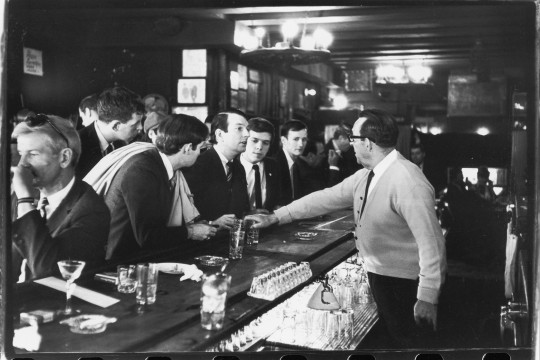
After pouring their drinks, a bartender in Julius's Bar refuses to serve (from left to right) John Timmins, Dick Leitsch, Craig Rodwell, and Randy Wicker, members of the Mattachine Society, who were protesting New York liquor laws that prevented serving gay customers, in New York, on April 21, 1966. Fred W. McDarrah—Getty Images
1 note
·
View note
Photo
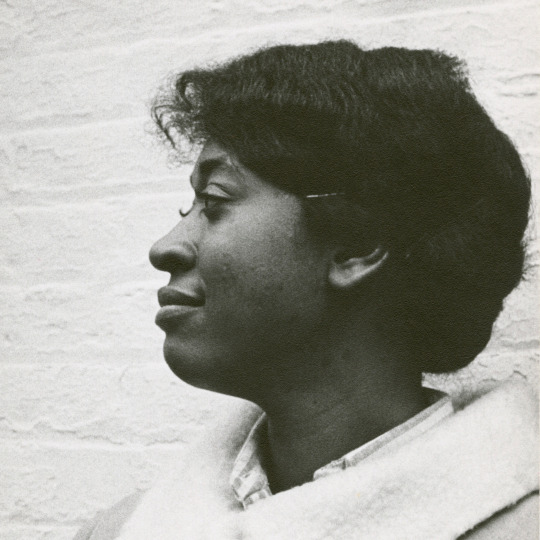
Ernestine Eckstein
An African-American woman who helped steer the United
States Lesbian and Gay rights movement during the 1960s.
She was a leader in the New York chapter of Daughters of
Bilitis (DOB). Her influence helped the DOB move away from
negotiating with medical professionals and towards tactics
of public demonstrations. Her understanding of, and work in,
the Civil Rights Movement lent valuable experience on public
protest to the lesbian and gay movement. Eckstein worked
among activists such as Phyllis Lyon and Del Martin, Barbara
Gittings, Franklin Kameny, and Randy Wicker. In the 1970s
she became involved in the black feminist movement,
in particular the organization Black Women Organized for
Action (BWOA).
0 notes
Photo

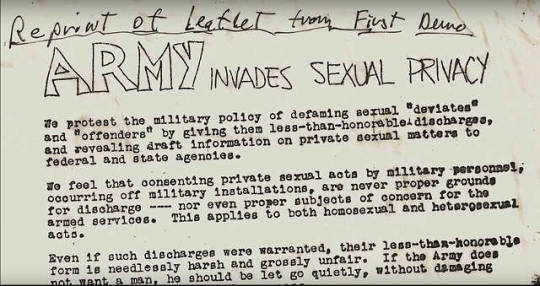
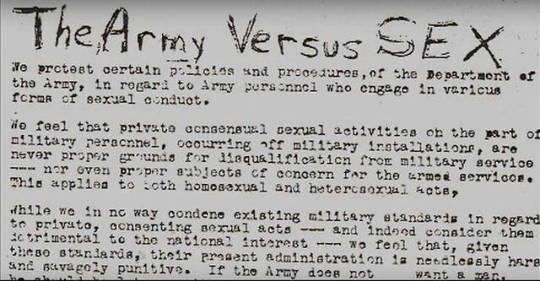


September 19, 1964. The first gay picket! 10 women and men (4 gay and 6 straight supporters) picket at the U.S. Army induction center on Whitehall Street in lower Manhattan to protest Arn1Y rejection of gays and issuance of 1ess-thanhonorable discharges. (“We Don’t Dodge the Draft—The Draft Dodges Us”) - Barbara Gittings [download Queer America: a GLBT history of the 20th Century]
#history#barbara gittings#randy wicker#you can download the whole book!#it was organized by randy wicker#who went on to live with marsha p johnson!#the interconnectedness of the community is lovely to look back on
7 notes
·
View notes
Text
Emergency Room Games
5:00 a.m.
As I write this, David Combs, my life-mate, lays strapped to an IV on a portable stretcher a few feet away in N.Y.U. Medical Center's Emergency Room's corridor for the fifth consecutive night.
We got "primo" space our first night here — an alcove at one end of the crowded hallway "privatized" by a flimsy three-panel screen.
David arrived severely dehydrated. Moments after being processed, placed on a stretcher and attached to an I.V., his pulse dropped to 70 over zero.
"He's very weak," the supervising nurse announced solemnly, "his chances of surviving the night are slim."
"This is the best spot in the hall," she explained, jostling several stretchers around, maneuvering us in and placing the screen. "It's more private here."
"Why is he sweating so?" I asked.
"He's probably going into shock. The sweating is a sign his body's systems are beginning to shut down."
Fifty days warehoused in Hoboken's St. Mary's Hospital dealing with PCP and a partially collapsed lung, followed by five days of uncontrolled diarrhea at home had brought us to our last gateway of hope — N.Y.U. Medical Center — which, according to those we thought should know, was simply "without equal."
Despite a million dollars worth of private medical insurance, and even a couple of contacts with well-placed, big-name docs, we found the inn was full.
Yuppie Truth. Thousands of dollars spent on insurance the last three years and here we were sharing a fluorescent-lit hallway with two drug users rapping about jail experiences; a chubby middle-aged executive with a walrus moustache screaming in pain from a back injury; a pale, groaning, elderly woman attached to a bubbling, beeping cardiac monitor; a handsome suave young clone tended by his lover; an hispanic PWA fouling his new wraps and bedding almost as quickly as the harried nurses' aides changed them; and a half dozen others.
Reality sandwich — too many people, not enough room. Upper class, middle class, lower class; drug heads, fag heads, executives — all human flotsam and jetsam floating around the hospital hallway, all waiting for those already-filled rooms. Neither money, nor insurance, nor need could get a room that wasn't.
Politics of life and death. Social worker games — "We can get you a room at another hospital — St. Clare's, Beth Israel, Bellevue, Doctor's Hospital." A few faces disappear.
Politics of life and death. Nurses' games — "We can arrange nursing care at home. Take him home. You can do almost as much for him at home as we can do here." More faces disappear.
A rotund woman in her late sixties sits in a chair. Sleeps upright all through the night. Nerve damage up and down her left side. Ten days sitting and sleeping in the chair waiting for a bed upstairs.
"Those rich folks upstairs have beds," she pains, "rich folks with insurance." I say nothing but silently cheer when she gets a bed the following day
"Every AIDS patient must have their own private room. Hospital policy!" the medics explain. "No telling when you'll finally get in — days and days, weeks."
"Of course you can leave any time, A.M.A. — Against-Medical-Advice. We can arrange an ambulance home and nursing care. Your insurance will pay for it."
"Oh no, you can't go into Co-op care here. You're too sick for that. No I.V.'s allowed in Co-op care."
"Well enough to go home," I puzzled. "But not well enough to go into Co-op care?"
"Oh no! Sir. I didn't say that."
"You must sign out A.M.A. — Against Medical Advice," the social worker, the nurse, the attending physician, all explain.
And when pressed, they add, "A.M.A. means you really shouldn't go home."
"I'm going nuts! I can't stand this place anymore! Get me out of this damn corridor!" Those words echo day after day, bouncing stretcher to stretcher down the hall. A few more faces disappear.
"He really wants to be at home," an overseeing physician counsels when he phones me in Jersey. I'd been relieved after 36 hours by a friend. "And a patient's wishes, they're very important to me."
"I've been talking to David about going home. He very much wants to be at home with you," the social worker confides when she calls a few minutes later. "What are the chances of that happening?"
"David's not coming home to shit himself to death without medical attention on my couch," I respond firmly. "You're better equipped to deal with his medical problems than I am."
I'd actually been wavering.
"Oh take him home," friends good-heartedly counseled.
"Please! Please! Please!" David himself begged.
It was hard to say "no." David would have to come to my apartment where I and others could care for him.
I held Power of Attorney. David told them to have me sign the "Do-Not-Resuscitate" order that first evening.
Care partner games. Patient games. Life and death games. Why so many calls from the hospital as soon as I came home?
Realization earthquake. A giant crack had opened in the middle of the road — a sharp, clear dividing line.
There I was on one side, at home — and on the other side were the medical folks doing what they had been trained to do, albeit almost unwillingly — caring for David.
The social worker games, the nurse games, the doctor games had failed. We'd wait to get that room. Our faces were not going to disappear.
— Randy Wicker, OutWeek Magazine No. 16, October 8, 1989, p. 31.
1 note
·
View note

